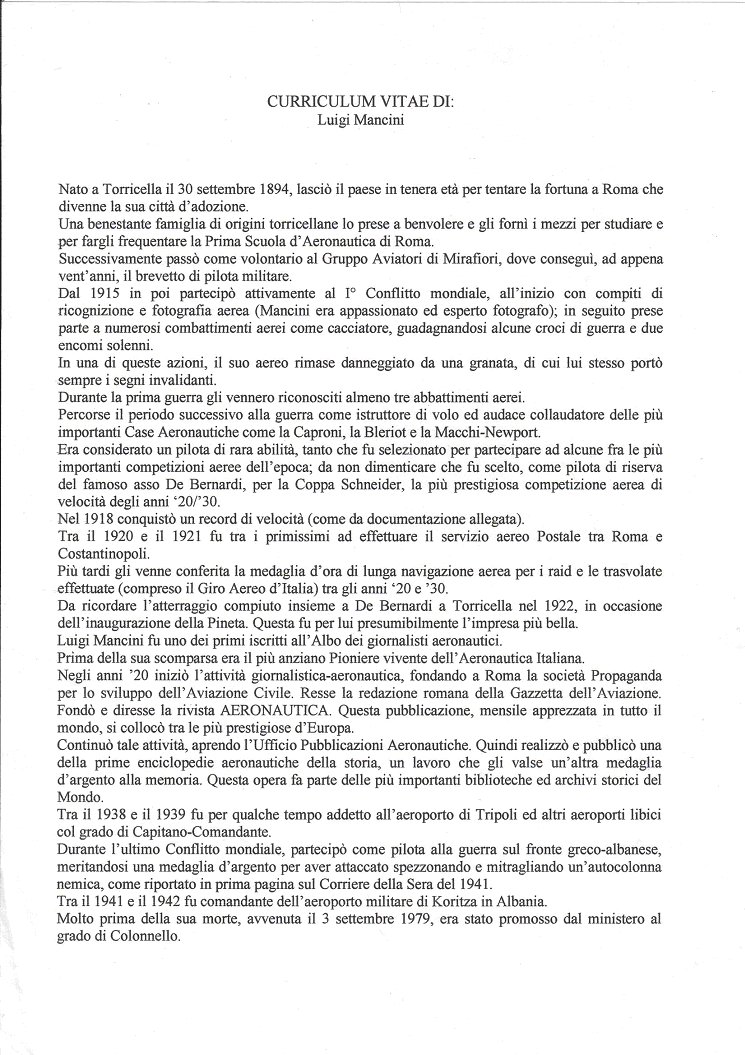|
CURRICULUM VITAE
Luigi Mancini (1894 Ė 1979)
Born in Torricella on 30th September 1894, he left the
village at a young age to seek his fortune in Rome, which became his
adopted City.
A well-off family originally from Torricella took kindly to him and
provided him with the means to study and attend the First School of
Aeronautics in Rome.
Later he became a volunteer with the Aviators Group of Mirafiori, where
at only 20 years of age he obtained his military pilotís license.
From 1915 onwards he played an active part in the First World War, at
the beginning doing reconnaissance work and aerial photography (Mancini
was an impassioned and expert photographer); later he took part in many
air battles as a fighter pilot, earning several War Crosses and two
solemn citations.
In one of these actions, his plane was damaged by a grenade, which also
caused him permanent injuries.
During the First World War he downed at least three (enemy) airplanes.
After the War he was an air instructor and a test pilot for some of the
most important Aeronautic Firms such as Caprossi, Bleriot and Macchi-Newport.
It was recognised that he was a pilot of rare ability, so much so that
he was chosen to take part in some of the most important air
competitions of that era; it should not be forgotten that he was chosen
to be reserve pilot to the famous ace, De Bernardi, for the Schneider
Cup, the most prestigious air speed competition of the 1920ís and
1930ís.
In 1918 he beat a speed record (as shown in the attached documentation).
Between 1920 and 1921 he was amongst the very first to carry out Postal
Air Service between Rome and Constantinople.
Later he was awarded the Gold Medal for long-distance navigation for the
raids and crossings he carried out (including the Air Tour of Italy) in
the 1920ís and 1930ís.
Of note was his landing in Torricella in 1922, carried out together with
De Bernardi, for the inauguration of the Pineta (the Pinewood Park). For
him this was presumably his most beautiful undertaking.
Luigi Mancini was one of the first to be enrolled on the register of
aeronautical journalists.
Until he died he was the oldest living Pioneer of the Italian Air Force.
In the 1920ís he began his career as an aeronautic-journalist, founding
in Rome the Propaganda Society for the Development of Civil Aviation. He
was Editor of the Aviation Gazette in Rome. He founded and directed the
AERONAUTICS Review. This quarterly publication was well-received all
over the world, and became one of the most prestigious in Europe.
He continued with these activities and opened the Aeronautics
Publication Office. Then he wrote and published one of the first
aeronautical encyclopaedias in history, which work won him another
posthumous Silver Medal in his memory. This work forms a part of the
most important library and historical archive in the world.
For a time between 1938 and 1939, he was attached to the airport in
Tripoli and other Libyan airports, with the rank of Captain-Commander.
During the Second World War he was a pilot on the Greek-Albanian war
front, gaining a Silver Medal for having attacked, bombed and shot an
enemy motor-column, as was reported on the front page of the Corriere
della Sera (newspaper) in 1941.
Between 1941 and 1942 he was Commandant of the military airport at
Koritzia in Albania.
Long before his death on 3rd September 1979, the Ministry promoted him
to the rank of Colonel.
Translation courtesy of
Dr. Marion Apley Porreca |

